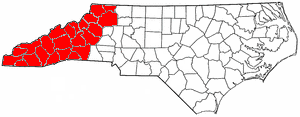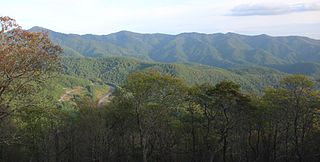Townships
The county is divided into fifteen townships:
Barker's Creek: Named for the creek which starts here and flows through the township before entering the Tuckasegee River. It includes the Dicks Creek, Barkers Creek, and Wilmont communities. US 74/23 runs as a four-lane divided highway through the township. The township is served by Smokey Mountain Elementary School and Smoky Mountain High School. Formerly, the Log Cabin Association Consolidated School served the township, but it closed in 1980 when Smokey Mountain Elementary opened.
Canada: Named for the tall ridges, narrow valleys, and sharp peaks of this part of the county, the main waterway is the East Fork of the Tuckasegee River, which flows into the River Township before joining the West Fork, becoming the Tuckasegee River. There are four major lakes: Bear, Wolf, Tanasee Creek, and Ceader Cliff, in the township. It is served by NC 281 and is one of the most remote locations in the county. It is served by Cullowhee Valley School and Smoky Mountain High School. Before the 1990s, the schools for the area were Canada Consolidated School and Cullowhee High School, both closed in the 1980s.
Caney Fork: Named for the creek that flows through the township, which empties into the Tuckasegee River at East LaPorte. The main road is Caney Fork Road. The area is served by Cullowhee Valley School and Smoky Mountain High School. Prior to 1964, the schools that served the area were Johns Creek Elementary and Cullowhee High School.
Cashiers: Named for a lost horse, the town of Cashiers includes the communities of Panthertown Valley, Whiteside Cove, Fairfield, and Sapphire. It is served by NC 107 and US 64. The Eastern Continental Divide follows a ridge north of the township, and defines the boundaries between the Cashiers, Canada, and Glenville townships. The Chattooga, Horsepasture, and Toxaway rivers all originate or flow through the township. It is served by Blue Ridge School, which consolidated Glenville School and Cashiers Elementary in 1975.
Cullowhee: This is derived from the Cherokee name for the valley, which referred to a legendary figure, Judacullah. NC 107, Old NC 107, and NC 107-Alternate all serve the township as major roads; NC 107 is the only 4-lane roadway. Western Carolina University, the village of Forest Hills, and the communities of Speedwell, Old Cullowhee Road, Buzzards Roost, and Dicks Gap are all within the township.
In the nineteenth century, this was one of the first areas in the county to be settled by European Americansy, along with Caney Fork, River, Scott Creek, and Canada townships. It is the largest township by population according to the 2000 United States Census. The Cullowhee Creek, a tributary, and the Tuckasegee River both flow through the township; the confluence is around Old Cullowhee Road. The township is served by the local Cullowhee Valley School. Older children go to Smoky Mountain High School in Sylva. The former Cullowhee High School closed in 1988.
Dillsboro: Named after the Dills family who founded the town, the township also has the town of Dillsboro. Scotts Creek arises to the northwest, flowing from Scott Creek Township through Sylva Township into Dillsboro Township, where it flows into the Tuckasegee River. US 74/23, US 441, and NC 107 converge in two major intersections within the township. The township is served by Smokey Mountain and Fairview elementary schools and by Smoky Mountain High School. It has not had its own school since Dillsboro Elementary closed in 1951. The students were transferred to Log Cabin School in Barkers Creek Township, or Sylva Elementary School in Sylva township.
Greens Creek: Named for the creek which flows through most of the township before emptying into Savannah Creek, this township is served by US 441, a four-lane highway along the western edge. Greens Creek Road goes through the middle of the township. The township is served by Fairview Elementary School and Smoky Mountain High School. It was formerly served by the Savannah Consolidated School, from 1940 to 1973.
Hamburg: Named for the fort and original name of Glenville, the township is served by NC 107. The area was once a large valley, but the valley was flooded in 1941 by a dam on the Tuckasegee River, which formed Lake Glenville. The West Fork of the Tuckasegee River originates within the township, and flows north into the River Township. Blue Ridge School is located in the township and serves the township. It developed in 1975 from the consolidation of the Glenville School and Cashiers Elementary School.
Mountain: Named for Cullowhee Mountain, this township is served by NC 107 Alternate. The headwaters of Cullowhee Creek are located here, flowing north into Cullowhee Township before joining the Tuckasegee River. It is served by Cullowhee Valley School/Smoky Mountain High School in Cullowhee and Sylva, respectively. It was formerly served by Cullowhee High School and Camp Lab Elementary.
Qualla: Named for the Qualla Boundary, which occupies most of the township, Qualla Township is served by US 441, US 19, and US 74/23. Smokey Mountain Elementary School is located in the township, resulting from the 1980 consolidation of Qualla Elementary School and Log Cabin Association Consolidated School. It is served by the Jackson County Public School System and the Cherokee Reservation School System. Students can choose among Smokey Mountain Elementary/Smoky Mountain High School, Cherokee School, or Swain East Elementary, Swain Middle School, and Swain High School. A Cherokee language immersion school has been founded in the township. The communities of Qualla, Birdtown, Soco, Whittier, Indian Hills, and Wilmont are all located at least partially, if not wholly, within the township.
River: Named for the Tuckasegee River, which is formed within the township by the confluence of two streams, it is served by NC 107 and NC 281. The community of Tuckasegee is located in the township. It is served by Cullowhee Valley School/Smoky Mountain High School. Prior to 1958, Tuckasegee School and Cullowhee High School both operated here.
Savannah: Named for Savannah Creek, which runs through the district, this township includes the Viewpoint, Pumpkintown, Savannah, and Fort Wilderness communities. The township is served by four-lane US 441. Fairview Elementary School and Smoky Mountain High School serve the township as well. From 1940 to 1973, it was home to Savannah Consolidated School. Its higher-grade students went to Webster High School and now Sylva-Webster High School.
Scotts Creek: Named for Scotts Creek, which starts here and flows through the township before passing into Sylva Township. It is served by US 74/23 and old US 19/23, which run through the five communities within the township: Balsam, Willets, Ochre Hill, Addie and Beta. The Murphy Branch Railroad also runs through the township. Scotts Creek School has served the township since 1951. It had a new building constructed in 2001. The old school building is now used for the Jackson County School of Alternatives (the HUB).
Sylva: Named for William D. Sylva, as is the town and county seat of Sylva, located within the township. It is served by NC 107, US 74/23, and BUS 23. The Jackson County Courthouse and Library are both located in the township. Scotts Creek runs through the township before flowing into the Tuckasegee in Dillsboro Township. The township is served by Fairview and Scotts Creek elementary schools and Smoky Mountain High School; the latter serves all the county. Consolidation since the late 20th century closed many smaller schools in the county.
Webster: Also the site of the town of Webster, this township is at the original geographical center of the county. Due to territorial changes, that is now Cullowhee Township. For many years, it had the only town in Jackson County. It is served by NC 116 and NC 107. The county seat designation and courthouse were located here from 1851 to 1913. Since Sylva was designated as the county seat, Webster lost business. The schools that serve the township are Fairview Elementary School (1973) and Smoky Mountain High School (1960/1988).





















